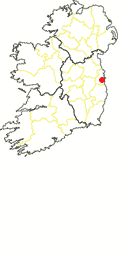
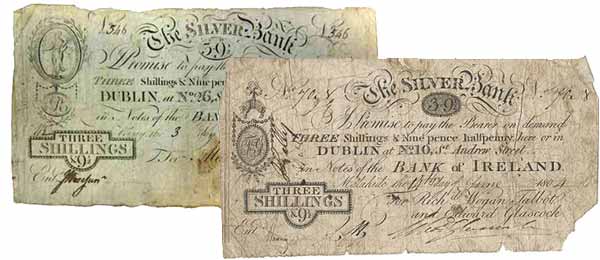
This page is currently under revision. Last updated 06.08.23
Research suggests that there were two different banks called the Silver Bank. The first Silver Bank was based in Malahide and was a renaming of the Malahide Bank, after a change in partnership and operating procedures of that bank. The second Silver Bank was opened in Bray shortly after the Silver Bank, Malahide ceased operating.
The two 'Silver Banks', the first in Malahide, and second in Bray, were both close to Dublin, but outside the city boundary. The first bank, was founded as the Malahide Bank by Richard Wogan Talbot in 1803, with two other partners, Hon. John Leeson, and Edward Glascock. It was renamed ’The Silver Bank’ in 1804 after Leeson left the partnership.
Malahide Bank was registered on 10 March 1803. Located in Malahide, north Co. Dublin, its Dublin agent was John Rose Baker, based in William St, in the city centre.
The Silver Bank, Malahide began operating from at least 13 July 1803 [1. Saunder's Newsletter, 1803] after Leeson left the partnership. It was registered on 27 January 1804. Located in Malahide, its Dublin agent was Mason and Thomas at 10 St. Andrew St, indicating that John Rose Baker also ceased to be associated with the Malahide-based bank. A notice in Saunder’s Newsletter (13th July 1803) mentions the agency change.
Available evidence suggests that the Silver Bank, Malahide failed in mid-1804.
The Silver Bank, Bray was founded by Alderman John Rose, who was the sole partner. The bank was completely separate from the Malahide Silver Bank. It operated from at least 28 June 1804 (earliest recorded note). Its Dublin agent was based at 26 St. Andrew St. and appears to be a Francis Castro, described as a grocer residing at this address in Wilson’s Almanac 1804.
It is believed currently that the Silver Bank, Bray was closed around August 1804 with all debts being paid in full.
Previous studies of the 'Silver Bank' appear to have not uncovered the existence of two silver banks, and all the published accounts, including Kenny and Turner (2019) [2], and Young (1974) [3] concluded that the Silver Bank was wound up in an orderly manner with creditors paid, which is at odds with the report of a bankruptcy court case against Glascock in 1808, reported in The Globe Newspaper, London [4].
John Rose Baker and Alderman John Rose were likely two different individuals
The journal of the House of Commons Volume 59 lists John Rose Baker on 9 March 1804 as 'Treasurer of Public Money of City of Dublin' [5]. Watson’s Almanac 1804, lists John Rose Baker as a 'Money Treasurer, based in William Street'.
Watson's almanac also lists Alderman John Rose of William Street as being a South Side (meaning south of the River Liffey) Divisional Justice [6].
This indicates that there were two people named John Rose residing at the same address.
Young (1989) [7] suggests that there was one John Rose. However, this suggestion was made with reference to Alderman John Rose's Series 1 Ticket issue and in the context of the Malahide Bank John Rose Baker, and without reference to Alderman John Rose's Bray Silver Bank notes, Series 2.
More research remains to be done on this.
The 1799 Act forbade banks within the city of Dublin from issuing small notes, those with a value of under 5 Guineas. Banks outside the city, the so called 'country banks', were permitted to issue small notes.
Because there was a chronic lack of small denomination coins in circulation at the time, there was a demand for small denomination notes with a value under 20 Shillings, in Dublin as well as the rest of the country.
Notes of denominations below 20 Shillings were referred to as 'Silver Notes', and the permitted denominations of these notes were specified in legislation as 3 Shillings 9 and a half pence (3s.91⁄2d, equal to one sixth of a Guinea), 6 Shillings (6s), and 9 Shillings (9s). Many banks issued these denominations, including O'Neill's Bank in Waterford which issued a great many of them, and Ffrench's Tuam Bank, which issued relatively few in terms of its overal note issue.
Two banks which specialised exclusively in the issue of these denominations used the title 'The Silver Bank' on their notes.
The Malahide Bank and later the two Silver Banks in Malahide, and then in Bray, Co. Wicklow were founded outside the city limits to address this lack of small denomination currency in Dublin. They produced notes for circulation in Dublin, but not issued in Dublin.
An 1804 Act (44 Geo. iii, c.91) declared all notes under 20 Shillings invalid. This Act resulted in the withdrawal of all the notes of the Silver Banks, and in the orderly closure of the Silver Bank in Bray which issued only 'Silver Notes'.
The golden Fleece symbol, a sheep suspended by a ribbon, was the emblem of the Order of the Golden Fleece, founded in 1430 and became a symbol of fine wool in Europe from the 1400s.
The Malahide bank appears to have been founded on good solid principles. However, within a year some event triggered a break in the partnership, with the departure of John Leeson from the business. The highly respectable John Rose Baker also appears to have ceased being the Dublin agent for the partnership around this time.
The bank continued with the other two partners, and a different agent in Dublin.
The three partners of the Malahide bank were well connected in Dublin society. Talbot later became Lord Talbot de Malahide, a title he inherited from his mother who had been created Baroness Talbot de Malahide in 1831, Leeson was the second son of the Earl of Milltown (Co. Dublin), and Glascock was the son of William Glascock who had been secretary to the Lord Mayor of Dublin in 1776.
Talbot had been a member of Parliament for Dublin five times. He had later started a business to manufacture cotton fabrics in Ireland which had failed. It may be his connection to this industry which lead him to use the hanging sheep 'Golden Fleece' symbol on the notes issued by his bank.
He continued to be a significant figure in Dublin society after the failure of the Malahide Silver Bank and went on to become one of the first directors of the Provincial Bank of Ireland.
Relatives of both Leeson and Talbot gave their names to Dublin streets.
Malahide Bank Symbol, The Golden Fleece
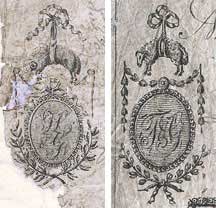
The golden Fleece symbol, a sheep suspended by a ribbon, was the emblem of the Order of the Golden Fleece, founded in 1430 and became a symbol of fine wool in Europe from the 1400s.
The use of the Golden fleece may have been a connection to Richard Wogan Talbot's previous business interests.
The report in The Globe, Thursday 22 December 1808 [4], suggests strongly that the Malahide Silver Bank failed with debts left unpaid. The court proceedings were filed based on Glascock’s refusal to pay out on the Malahide Bank’s notes (Stevenson v. W. Talbot Esq. & E. Glascock, Bankers).
The notes were said to have been traded at 1s for those denominated at 3s.91⁄2d shortly after the bank closed. Glascock was reported to have said that the 1804 Act prohibited him from paying out on the notes.
The Silver Bank was reported to have been operating out of a 'Shed' in Malahide, and to have been one of a number of banks stet up to produce small notes with face value under a Guinea to make up for a lack of silver coinage in circulation. It was noted further in the court case that businesses had to accept the notes due to this lack of coinage. Mention was made of the smart appearance of the notes of the Malahide Bank.
Two Series of notes are known for Talbot's bank
There are two Series for Talbot's Malahide Bank banknotes by design, and two Types by partnership.
Series 1A. 1803 March. Malahide Bank. Bank symbol of a hanging sheep above the initials of the three bank partners. Promise to pay the Bearer on Demand ... persuant to Act of Parliament Here or at J R Baker's, Dublin. This variety has been seen for a Six Shilling note dated 14 March 1803, which is illustrated below.
Series 1B. 1803. Malahide Bank. Slightly modified design of the bank symbol of a hanging sheep above the initials of the three bank partners. Promise to pay the Bearer on Demand ... persuant to Act of Parliament Here or at John Rose Baker's, William St. Dublin.
Series 2. 1804. Silver Bank replaces Malahide Bank in heading. Slight alterations in the design of the bank symbol of a hanging sheep above the initials of the bank partners. Promise to pay the Bearer on Demand ... here or in Dublin at No.10 St. Andrew St. in Notes of the Bank of Ireland.
Two Types by partnership.
Type A: 1803. Malahide Bank. Richard Wogan Talbot, John Leeson, Edward Glascock. Registered 10 March 1803.
Type B: 1804. Silver Bank, Malahide. Richard Wogan Talbot, Edward Glascock. Registered 27 January 1804.
Denominations recorded: 3s.91⁄2d, 6s, 9s.
Printers: unknown.
Series 1, Type A. Malahide Bank
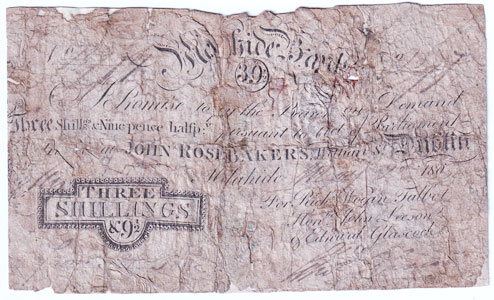
Malahide Bank, 3 Shillings 9 and a half pence, Richard Wogan Talbot, John Leeson, Edward Glascock (Left side with logo clipped off)
Dates recorded: 2 May 1803, 1 Aug 1803. On this note 91⁄2d is abbreviated to Nine pence halfpy.
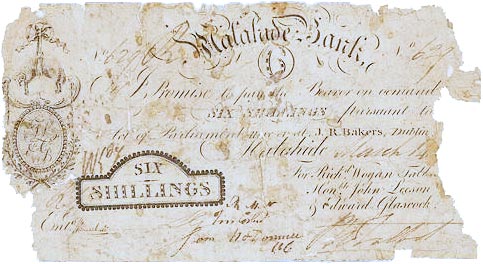
Malahide Bank, 6 Shillings, 14 March 1803
Dates recorded: 14 March 1803, 2 May 1803.
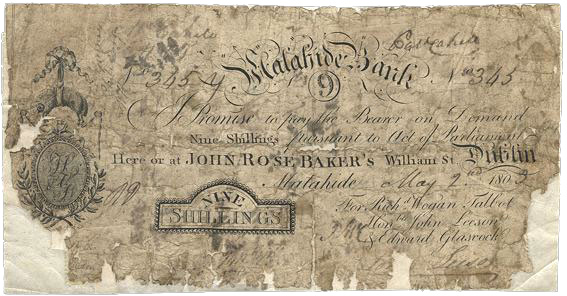
Malahide Bank, 9 Shillings, 2 May 1803. Richard Wogan Talbot, John Leeson, Edward Glascock
Dates recorded: 14 March 1803, 1 April 1803, 2 May 1803. Others likely.
[10. noonans.co.uk, 14 March 2009, Lot 497]
Denominations recorded: 3s.91⁄2d, 6s, 9s.
Printers: unknown.
Series 2, Type B. The Silver Bank
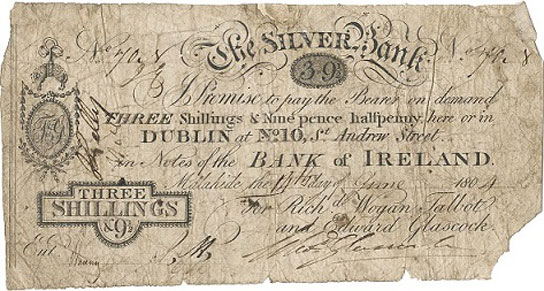
The Silver Bank, Three Shillings & Nine pence halfpenny, 14 June 1804. Richard Wogan Talbot, Edward Glascock
Dates recorded: 14 June 1804. Others likely.
[11. noonans.co.uk, 2 Oct 2008, Lot 17]
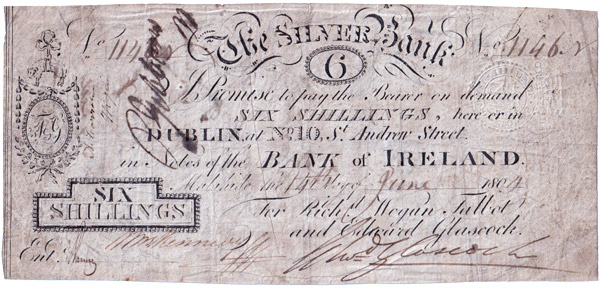
The Silver Bank, Malahide, 6 Shillings, 14 June 1804. Richard Wogan Talbot, Edward Glascock
Dates recorded: 1 Feb 1804, 14 June 1804. Others likely.
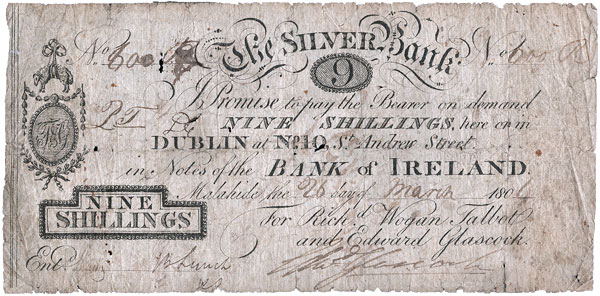
The Silver Bank, Malahide, 9 Shillings, 26 March 1804. Richard Wogan Talbot, Edward Glascock
Dates recorded: 26 March 1804, 9 June 1804. Others likely.
[12. noonans.co.uk, 31 March 2011, Lot 2220]
This bank is obscure and not mentioned in the 1804 House of Commons report [8]. However, a reference to it exists in Saunder’s Newsletter (13 August 1804) [9] in which Alderman John Rose is listed as a banker registered in Bray (Co.Wicklow).
Three notes have been recorded to date which confirms that the bank operated for a short time.
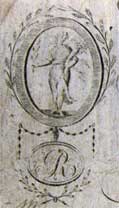
It appears to have been founded after the failure of the Malahide Silver Bank, sometime before 14 June 1804, and can only have been in business for a few months before the change in law prohibiting the low denomination notes it issued lead to its closure.
There is no evidence to suggest that the bank failed prior to closure. In the absence of evidence to the contrary we assume that the Alderman John Rose's Silver Bank was closed in good order with all debts paid in full.
Although the notes issued by the Silver Bank, Bray are similar in design to those of the Silver Bank, Malahide, on a close examination of the design detail on the notes, the engraving on the Bray notes is entirely different, and better quality than those of the Malahide notes.
It is possible that the two banks shared the same printer, given the similarity of their note designs, though there is currently no evidence to support this.
The Bray Silver Bank's symbol is composed of a somewhat generic female figure, similar to that used on the notes of other banks, above the letter R.
Denominations recorded: Series 1: 2s.2d; Series 2: 3s.91⁄2d, 6s, 9s.
Printers: unknown.
There are two Series of notes issued by Alderman John Rose by design, and one Type by partnership.
His early issue, May 1804 and designated here as Series 1, is that of a Promissory Ticket payable in Dublin at 17 William St. One example of such a note has been seen (Young, 1989), denominated at 2 shillings and 2 Pence, which corresponded to 2 English Shillings at the time.
His later issue, July 1804, Series 2 are more formal notes which were issued in Bray, and payable in Dublin at 26 St. Andrew's St., Dublin.
Series 1. 1804, May. I will receive this Ticket as Two Shillings and Two Pence in any payment to be made to me No. 17, William Street Dublin.
Series 2. 1804, July. Bank title 'The Silver Bank'. Promise to pay the Bearer on Demand here or in Dublin at No.26 St. Andrew Street in Notes of the Bank of Ireland.
Series 1, Ticket issue, Alderman John Rose

Promissory Ticket, Dublin, 2 Shillings & 2 pence, 16 May 1804. Alderman John Rose
Dates recorded: 16 May 1804. Actual relative size unknown.
[7. Irish Numismatics, Coin & Medal News, Token Publishing, 1989]
Series 2,The Silver Bank, Alderman John Rose
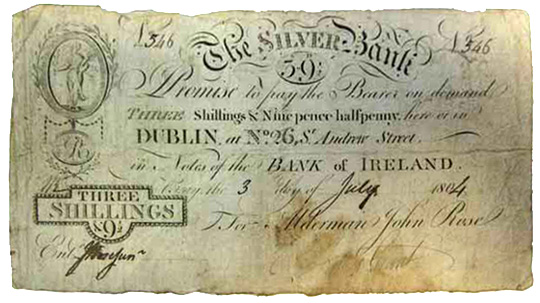
The Silver Bank, Bray, 3 Shillings & 9 pence halfpenny, 3 July 1804. Alderman John Rose
Dates recorded: 14 June 1804. Others likely.
The Silver Bank, Bray, 6 Shillings, 25 June 1804. Alderman John Rose - Picture of this Denomination Sought
Dates recorded: 25 June 1804
References
1. Saunder's News Letter 13th July 1803.
2. Kenny, S., Turner, J. D. (December 2019). 'Wildcat bankers or political failure? The Irish financial pantomime, 1797–1826', European Review of Economic History 24(4).
3. Young, D. (March-April 1974). The Private Banks and Their Notes, Talbot & Co. (Malahide Bank) 1803-1804, Irish Numismatics Magazine, No. 38, pp. 81-83.
4. 'The Globe' Newspaper, London, Thursday 22 December 1808, report on court proceedings against Glascock.
5. Journal of House of Commons Volume 59, Appendix A, p496.
6. Watson's Almanac, 1804.
7. Young, D. (1989). Irish Numismatics, Notes of Non-Bankers, Coin and Medal News, February 1989, pp 68-69, Token Publishing.
8. Report from the Committee on Circulating Paper, the Specie and the Current Coin in Ireland; and also on the Exchange between that Part of the United Kingdom and Great Britain. House of Commons, 1804. (1826 reprint).
9. Saunder's Newsletter, 13th August 1804.
10. Auction Catalogue, Noonan's (DNW), London. Important Collection of Irish Paper Money formed by Bob Blake (Part II), 14 March 2009.
11. Auction Catalogue, Noonan's (DNW), London. Important British, Scottish and World Paper Money, 2 Oct 2008.
12. Auction Catalogue, Noonan's (DNW), London. British and World Paper Money, 31 March 2011.
13. Day, R. "Silver notes in the County Cork", Journal of the Cork Historical and Archaeological Society, 1895, Vol. 1, No. 1, pp. 33-34. Digital file created: November 24, 2013.